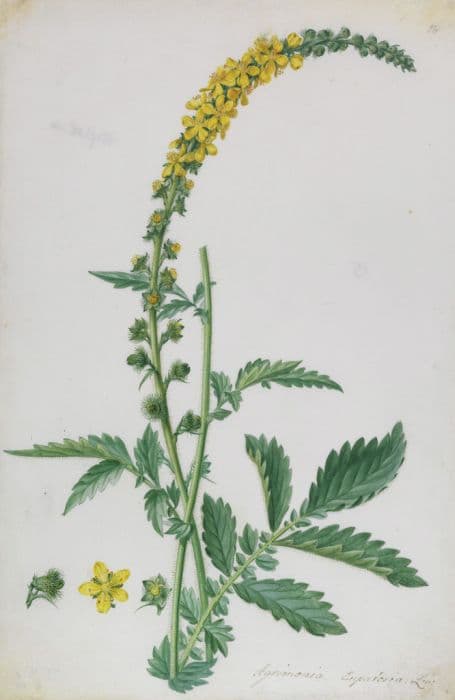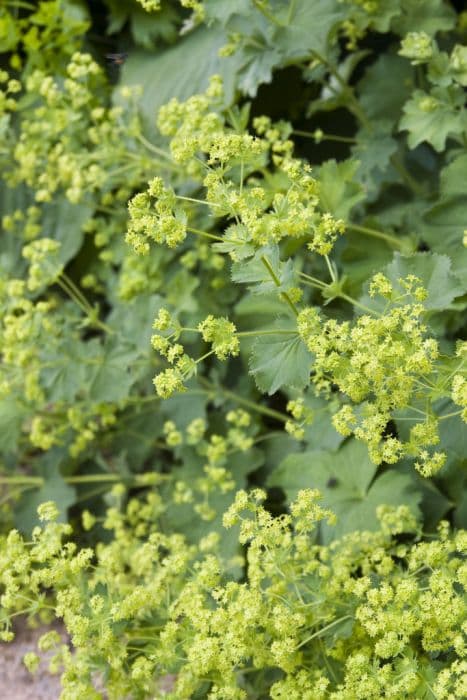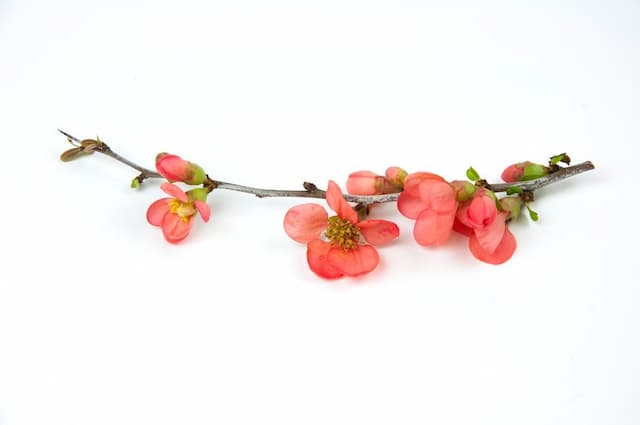Goatsbeard Aruncus dioicus 'Kneiffii'

ABOUT
Aruncus dioicus 'Kneiffii', commonly known as goat's beard, is a herbaceous perennial plant favored for its ornate foliage and attractive feathery plumes. The leaves are compound and deeply dissected, giving them a fine, lace-like texture. Each leaf is divided into smaller leaflets that are sharply toothed, creating an intricate, fern-like appearance. These leaves tend to be a rich green color, adding a lush, decorative element to garden spaces. As for its flowers, the goat's beard produces tall, erect plumes that are creamy white in coloring and appear to be quite delicate and airy. These feathery blossoms are clustered on narrow, branching spikes, forming an upright and panicle-like shape that can lend a soft, romantic look to the landscape. These flowering stalks emerge above the foliage and make an elegant statement with their grace and lightness. Overall, the goat's beard provides a natural, wild garden aesthetic with its finely cut foliage and lofty flower panicles. Its ability to blend with other plants and create a backdrop of verdant texture with soft floral tones makes it a choice plant for ornamental gardens. Its appearance can evoke a sense of an enchanted, woodland setting.
About this plant
 Names
NamesFamily
Rosaceae.
Synonyms
Goatsbeard, Bride's Feathers, Buck's-beard.
Common names
Aruncus acuminatus, Aruncus aethusifolius, Aruncus allegheniensis, Aruncus sylvester, Aruncus vulgaris.
 Toxicity
ToxicityTo humans
Goatsbeard is not considered poisonous to humans. In general, the plant doesn’t contain any known toxic compounds that would be harmful if ingested or cause skin irritation. However, as with any plant not intended for consumption, it is still advised to avoid ingesting it as it may cause gastrointestinal discomfort due to its non-dietary fiber content. There are no well-documented cases of poisoning or serious consequences stemming from the ingestion of any part of the Goatsbeard plant in humans.
To pets
Goatsbeard is not known to be toxic to pets. It does not contain toxic substances that would harm dogs, cats, or other domestic animals if they were to ingest parts of the plant. Ingestion may cause mild stomach upset in some pets due to the fiber content or unfamiliar plant matter, but it is not expected to cause serious or long-term health issues. Therefore, there are no specific symptoms of poisoning associated with pets consuming Goatsbeard, and the consequences of ingestion are typically minimal.
 Characteristics
CharacteristicsLife cycle
Perennials
Foliage type
Deciduous
Color of leaves
Green
Flower color
Cream
Height
3 feet (0.91 meters)
Spread
2 feet (0.61 meters)
Plant type
Herb
Hardiness zones
3
Native area
Europe
Benefits
 General Benefits
General Benefits- Ornamental Appeal: Adds aesthetic value to gardens with its feathery plumes of cream-colored flowers and finely cut foliage.
- Wildlife Attraction: Flowers provide nectar for pollinators like bees and butterflies, while its seeds attract birds.
- Low Maintenance: Once established, it requires minimal care, making it suitable for busy gardeners or those with limited time.
- Drought Tolerance: Has the ability to withstand periods of dryness once established, reducing the need for frequent watering.
- Shade Tolerance: Thrives in partial shade, making it a good choice for woodland gardens or darker areas of the landscape.
- Deer Resistance: Less palatable to deer, offering a solution for landscapes prone to deer damage.
- Erosion Control: Its robust root system helps stabilize soil and prevent erosion on slopes or in naturalized areas.
- Seasonal Interest: Provides visual interest throughout the growing season, with attractive foliage, blooms in late spring or early summer, and sometimes fall color.
- Long-Lived: Being a perennial, it returns year after year, contributing to a stable garden environment.
 Medical Properties
Medical PropertiesThis plant is not used for medical purposes.
 Air-purifying Qualities
Air-purifying QualitiesThis plant is not specifically known for air purifying qualities.
 Other Uses
Other Uses- Goatsbeard can be used in natural dyeing processes to achieve various shades of yellow or green depending on the mordant used.
- The dried flower plumes of Goatsbeard add texture and interest to floral arrangements and can be used in crafts or as decoration.
- In eco-friendly landscaping, Goatsbeard is utilized for soil erosion control due to its extensive root system.
- Goatsbeard is suitable for creating a naturalistic or woodland garden setting, being an attractive plant for larger landscape designs.
- The plant can be used in butterfly gardens as it attracts pollinators and beneficial insects with its flowers.
- Goatsbeard is sometimes planted around ponds or water features in gardens for its aesthetic contribution and to provide habitat for wildlife.
- In large garden spaces, Goatsbeard can serve as a living screen or privacy divider due to its tall and bushy growth habit.
- The plant can be incorporated into permaculture designs as part of a forest garden or food forest, even though it is not directly edible.
- Photographers and artists use Goatsbeard as a subject in natural landscapes to capture its delicate, feathery flowers.
- Some horticulture schools use Goatsbeard as a teaching tool to help students learn about plant identification and the characteristics of perennial plants.
Interesting Facts
 Feng Shui
Feng ShuiThe Goatsbeard is not used in Feng Shui practice.
 Zodiac Sign Compitability
Zodiac Sign CompitabilityThe Goatsbeard is not used in astrology practice.
 Plant Symbolism
Plant Symbolism- Femininity - Aruncus dioicus 'Kneiffii', commonly known as Goatsbeard, has graceful, feathery plumes of flowers that can symbolize softness and delicacy, often associated with feminine qualities.
- Protection - The robust nature of the Goatsbeard plant, which allows it to grow in various conditions, is frequently seen as a symbol of protection and adaptability.
- Purity - The white color of the Goatsbeard's flowers is widely regarded as a symbol of purity and innocence.
- Home and Hearth - Since Goatsbeard is often found in woodland settings and contributes to a natural, wild garden look, it can symbolize the comfort and safety of the home.
 Water
WaterGoat's beard requires consistent moisture but does not do well in overly saturated soils, so it's important to water it carefully. During the growing season, water it deeply once a week with about 1 gallon of water per plant, ensuring that the soil is moist but not waterlogged. In periods of drought or extreme heat, you may need to water twice a week. Adjust the frequency based on rainfall, as the goal is to maintain a steady level of moisture. During winter, reduce watering since the plant is dormant and excessive moisture can lead to root rot.
 Light
LightGoat's beard thrives in partial shade to full shade conditions. The ideal spot for this plant would be an area that receives dappled sunlight or light shade for most of the day, especially protection from the intense afternoon sun. It can tolerate some morning sun but should be shielded from strong midday rays to prevent scorching of the foliage.
 Temperature
TemperatureGoat's beard is a hardy perennial that can withstand a wide range of temperatures. It can survive minimum temperatures down to about -30°F, but the ideal growing conditions are between 65°F and 75°F during active growth. It can withstand summer high temperatures but prefers cooler conditions and may suffer in prolonged heat above 85°F without adequate shade and moisture.
 Pruning
PruningPruning goat’s beard is done primarily to remove spent flowers and tidy up the plant. After the flowering period, typically in late summer or early fall, cut the flower stalks back to the base to encourage a tidy appearance and prevent self-seeding if desired. Pruning can also include removing any dead or damaged foliage in the spring. The best time for heavy pruning is in late winter or early spring before new growth starts.
 Cleaning
CleaningAs needed
 Soil
SoilGoat's Beard prefers moist, fertile, well-drained soil with a pH of 5.5 to 7.0. The ideal soil mix can be a combination of loamy garden soil, compost, and a small amount of sand for improved drainage. Ensuring rich organic content is key to providing the nutrients this plant requires for optimal growth.
 Repotting
RepottingGoat's Beard does not need frequent repotting as it's a perennial plant that is normally grown outdoors; however, if grown in containers, repotting every 2-3 years or when the plant outgrows its container is adequate, ensuring minimal root disturbance.
 Humidity & Misting
Humidity & MistingGoat's Beard thrives in average to high humidity levels, typical of outdoor environments. While specific humidity levels aren’t critical, it benefits from a somewhat humid environment, especially if grown indoors, to mimic its natural setting.
 Suitable locations
Suitable locationsIndoor
Place in bright, indirect light, keep soil moist.
Outdoor
Plant in partial shade, moist soil, and cool area.
Hardiness zone
3-7 USDA
 Life cycle
Life cycleAruncus dioicus 'Kneiffii', commonly known as Goat's beard, begins its life cycle as a seed, which germinates in the spring after experiencing cold stratification over the winter. Once sprouted, the seedling grows into a juvenile plant, establishing a deep root system and a basal rosette of foliage. As it matures over the next two to three years, it develops into a herbaceous perennial, with distinctive, finely divided leaves and a growing clump-forming habit. In early to midsummer, the plant reaches a key stage as it produces tall, feathery plumes of cream-colored flowers that are attractive to pollinators. After flowering, the plant sets seed in late summer, with the seeds dispersed by wind, allowing for new plants to begin their life cycle. During autumn, the foliage of Goat's beard may turn a golden yellow before the plant enters dormancy in winter, completing its yearly cycle.
 Propogation
PropogationPropogation time
Spring-Early Summer
The most popular method of propagation for the goatsbeard (Aruncus dioicus 'Kneiffii') is by division of the plant's root system. The ideal time for dividing goatsbeard plants is in early spring or fall when the plant is dormant. To propagate by division, carefully dig up the entire plant with a shovel, making sure to keep a good amount of soil around the roots. Proceed to gently separate the plant into smaller sections, each with several shoots and a portion of the root system. It's important to replant the divisions at the same depth they were growing at originally, and space them approximately 2 to 3 feet apart (roughly 60-90 centimeters). Finally, water the new plantings thoroughly to help them establish in their new location. This method allows gardeners to quickly expand their collection of goatsbeard while ensuring the plants are true to the parent’s characteristics.









